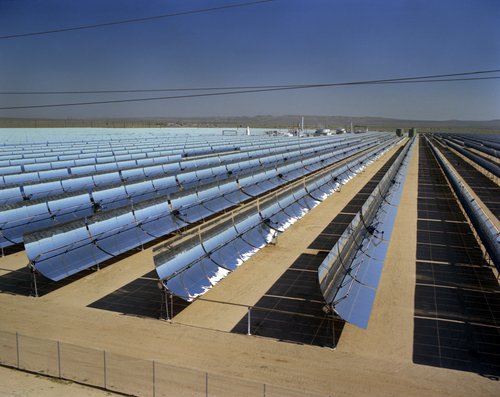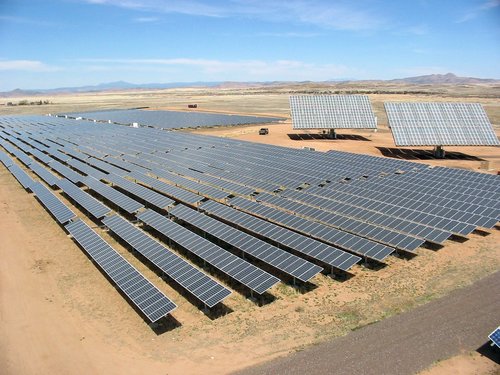
Solar
Solar Energy Resources
Solar energy is the conversion of the sun's rays into electricity. Solar energy can be used in a variety of ways to produce heat, light, fuel, or electricity. Although solar energy is ubiquitous, it is a variable energy-generating source with strong diurnal, seasonal, inter-annual, and geographic patterns. All regions of the United States have some solar resources available for power production, although their distribution and intensity vary based on atmospheric conditions and the type of collector. The highest solar resource areas in the Eastern Interconnection are generally found in the south, with the most intense solar resource areas falling outside the Eastern Interconnection in the southwestern United States.
There are three basic types of solar resources: direct normal (beam), diffuse (sky), and global (total) irradiance. Direct normal irradiance is the amount of radiation from the 'solar disk' (generally defined by a 5.7º field of view) on a surface perpendicular to the Sun's location in the sky. Concentrating solar collectors are designed to capture this form of solar energy. Diffuse irradiance is the amount of solar radiation reaching the Earth’s surface after being scattered from the direct beam. Diffuse irradiance data are useful for architectural daylighting applications and in photosynthesis. Global (typically global horizontal) irradiance is the geometric sum of the direct normal and diffuse irradiance components; it represents the amount of energy available from the entire sky dome on a planar surface.
Except for concentrating solar collectors that can use the direct normal solar resource, the collector types require various models of converting the three basic solar resources (global, diffuse, and direct) to be used to estimate the amount of solar radiation available to each collector type and orientation. Solar resource is typically reported in kilowatt-hours per square meter per day (kWh/m2/day) when measured over longer time periods (more than one day), and in watts per square meter (W/m2) when reported at finer time scales.
The solar resource intensity for energy conversion is affected by various factors, such as the site location (latitude, longitude, and elevation), time of day, season, cloud cover, atmospheric constituents that absorb or scatter solar radiation (e.g., water, dust, ozone), and characteristics of the solar energy collector type. Short-term temporal variability in the solar resource can occur at a single location due to rapid changes in these factors over a wide range of time scales (i.e., minutes to decades).
Solar Energy Technology
Solar resource technologies include concentrating solar power (CSP) and photovoltaic (PV).
CSP
Conventional CSP technologies concentrate the heat produced by direct solar beams collected by a transfer medium to power conventional steam turbine power systems. CSP uses reflective surfaces or lenses to concentrate the heat energy in sunlight over a large area into a small area. The most common conventional utility-scale technologies are the parabolic trough and solar power tower (also referred to as a central tower or heliostat power plant).
Parabolic trough collectors are arranged in long rows of curved reflective panel surfaces, with a collector tube filled with a heat transfer fluid located at the focal point of the curved surface (Figure 1). The heated fluid is transported to a heat engine, where the heat can be extracted. The longest operating CSP plants in the United States (solar electric generating system [SEGS] 1–9, totaling 350 MW) use this technology.

Solar power towers arrange the reflective surfaces in a circular area around a tall central tower. The surrounding mirrored surfaces concentrate the solar beam on a receiver at the top of the tower. The heat transfer medium is located in the tower itself; it is a molten salt. The molten salt flows into a storage tank, where the heat can be efficiently stored. Solar power towers can operate at higher temperatures than do parabolic trough systems, leading to higher system efficiencies and capacity factors. While only 5 MW is currently operational in the United States, construction is underway or under development for nearly 2 GW of additional capacity from solar power towers (NREL 2012b).
The collected heat energy from both of these types of system is then used to heat steam in a standard steam turbine generator that is similar to most conventional fuel sources. The heat energy can be stored to provide more flexibility in dispatching the energy produced to the grid and increasing the overall capacity factor of the solar plant (Denholm and Mehos 2011).
PV
Conventional utility-scale PV systems convert solar energy directly to electricity. Utility-scale PV uses arrays of solar panels that convert the solar energy received directly to electricity. The solar panels may be fixed, or they may be tracking collectors that tilt, either single-axis (Figure 2) or two-axis. Larger systems are typically mounted on the ground, but they may also occur on large commercial buildings or as combinations of ground-mounted and rooftop systems. By 2012 the United States had more than 7,300 MW of installed PV capacity, with another 1,300 MW under construction (Sherwood, 2012; EIA 2012).

Individual panels produce direct current (DC) electricity and are linked in an array by electrical conduit. The DC electricity must be converted to alternating-current (AC) electricity before it can be placed on the electric grid.
References
Denholm, P., and M. Mehos, 2011, Enabling Greater Penetration of Solar Power via the Use of CSP with Thermal Energy Storage. NREL/TP 6A20-52978. National Renewable Energy Laboratory.
EIA, 2012a, EIA-860 data tables, 2012 early release. Accessed September 2013.
NREL, 2012a, Photographic Information eXchange, NREL, Photo #01225, http://images.nrel.gov/. Accessed July 2012.
NREL (National Renewable Energy Laboratory), 2012b, Concentrating Solar Power Projects by Technology. http://www.nrel.gov/csp/solarpaces/by_technology.cfm. Accessed July 19, 2012.
NREL, 2012c, Photographic Information eXchange, NREL, Photo #13338, http://images.nrel.gov/. Accessed July 2012.
Sherwood, L., 2013, "US Solar Market Trends 2012," Interstate Renewable Energy Council, http://www.irecusa.org/wp-content/uploads/2013/07/Solar-Report-Final-July-2013-1.pdf. Accessed September 2013.

